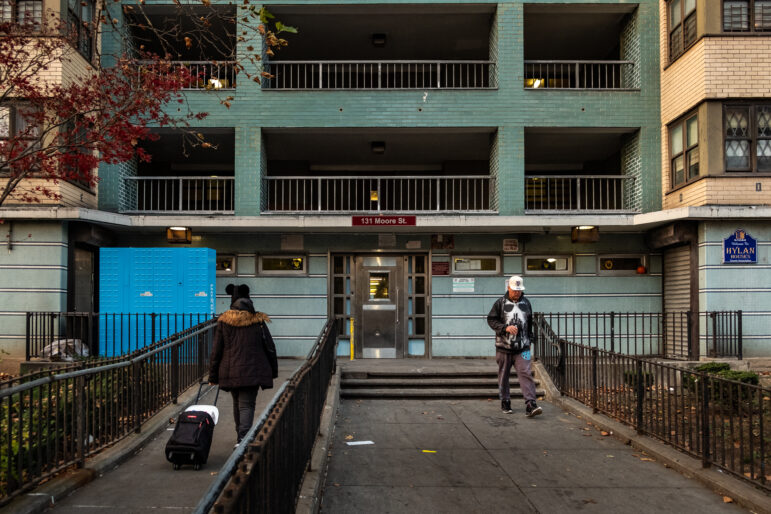
Sadef Ali Kully
A sign protesting rent collections in Brooklyn during the height of the Coronavirus epidemic.After eight years of rent freezes and modest increases, the days of a tenant-friendly Rent Guidelines Board may be coming to an end.
Mayor Eric Adams on Thursday tapped a landlord lawyer and a self-described rent control skeptic to fill vacant seats on the nine-member board, which sets legal rents for nearly 1 million regulated apartments across the city. Adams did not name a person to fill one of two tenant advocate positions on the board after his initial pick dropped out a day before the first meeting, according to people familiar with the selection.
Attorney Christina Smyth will serve as one of the board’s two landlord representatives, while New York University Stern business school professor Arpit Gupta, a fellow at the conservative Manhattan Institute, will serve as one of five public members.
“My administration is committed to making decisions based on data, and I know these two appointees share that commitment and will serve New Yorkers well in their respective roles,” Adams said in a statement.
The board consists of two tenant representatives, two landlord members and five theoretically non-partisan members, each appointed by the mayor. Under Mayor Bill de Blasio, the panel took the rare step of freezing rents on three occasions while imposing modest increases four other times. Last June, the board voted to freeze rents for six months starting Oct. 1, 2021 before allowing a 1.5 percent increase on one-year leases starting April 1. Two-year leases saw a 2.5 percent increase.
A spokesperson for Adams declined to comment on the vacant tenant member seat, a position tasked with advocating from the perspective of renters. “The mayor this week appointed two members of the board who share his commitment to safe, affordable housing for all New Yorkers,” the spokesperson said. “We do not comment on pending appointments, and no appointment is confirmed until it is formally announced.”
On the campaign trail last year, Adams signaled that he would be more open to the demands of property owners, who have called for significant rent hikes, than de Blasio. He said in June 2021 that he opposed a rent freeze and cited the experience of small property owners of color who face rising costs.
The board’s pro-tenant posture under de Blasio infuriated property owners and their representatives who said they were struggling to keep up with rising costs. Tenants, meanwhile, said they face the prospect of eviction or a significant rent burden in a tight rental market.
A report released Thursday by the Rent Guidelines Board shows that landlords still managed to earn income from “nearly all buildings” with stabilized units in 2020, but their profit margins decreased by 7.8 percent, the biggest drop since 2003. Apartments in buildings with stabilized units generated an average of $545 of net income per month in 2020, according to the report. Units in post-war buildings made about $735 per month, while prewar apartments generated about $461 a month.
The board uses the analysis to determine how much to raise rents or whether to freeze rates. They also have the ability to roll rents back.
Gupta, an economist specializing in large data sets to analyze real estate and household finance trends, declined to be interviewed for this story. In a statement released by the mayor’s office, he said he has “a strong commitment to keeping New York City affordable, while balancing the needs of all housing stakeholders.”
He previously told the news site Vox that he is a “little skeptical of rent control”—a perspective shared by many economists who say new rent regulations do not address the root problem of housing scarcity.Studies show that rent regulations do, however, prevent displacement because they cap annual price increases.
The rules governing rents on more than 1 million New York City apartments have been in place since 1969. After landlords managed to permanently remove more than 150,000 units from the stabilization rolls, state lawmakers beefed up the rent laws in 2019 to limit landlords’ ability to deregulate units and raise rents on stabilized units, even after they become vacant.
The stabilization system is seen as a pillar of New York City’s affordable housing infrastructure, as representatives from the city’s housing department testified at a Council hearing last month.
In that context, Sheila Garcia, the director of organizing at the organization New Settlement and the lone tenant representative left on the rent board, said she considers Gupta’s rent control outlook “extremely problematic.”
“This is a board that is supposed to manage what rent stabilization looks like and they can’t be skeptics,” Garcia said. “That undermines the whole process of what we’re supposed to do as a board.”
She said she was also concerned by the lingering tenant vacancy, especially since members meet to discuss reams of data before making a decision.
“It was really disappointing not to see another person appointed, especially in a critical year,” she added.
Smyth, Adams’ pick for landlord member, has criticized the 2019 Housing Stabilization and Tenant Protection Act (HSTPA) that extended renter protections and has shared some of her perspective on Twitter. Last month, for example, she said she supports “means testing” for rent-stabilized apartments and would like the state to “bring back high income deregulation.”
“NYC Landlords are some of the hardest working individuals I have met in my career. I’m pleased to represent them and all New Yorkers on the #RGB,” she tweeted following her appointment Thursday.
Smyth runs a real estate law firm and said she was unavailable for an interview for this story.
Tenant groups say they are worried about the direction of the board ahead of a vote in June. A collection of organizations known as the Rent Justice Coalition rallied outside the meeting Thursday to demand a rent rollback as well as in-person evening hearings with more time for the public to speak. They were joined by Councilmembers Shaun Abreu and Kristin Richardson Jordan.
Tenant organizer Brittany Robinson from the organization Tenants and Neighbors said the two board appointments were not surprising, but “concerning for what we’re advocating for—a rent rollback and no rent increases.”
“You’re not going to see that with a pro-landlord board,” she added.
Coalition members say tenants are still dealing with the impact of the COVID pandemic and economic decline. “They can barely afford their rents and to have increases looming over them is very stressful,” Robinson said.
Landlord groups, on the other hand, say it is well past time the board raises rents to offset property taxes, heating costs and repairs. They have also cited a decline in rent collection during the pandemic. More than 430,000 New York City households remain behind on their rent, according to data compiled by the policy group National Equity Atlas. Landlords who did not receive reimbursement from the state’s Emergency Rental Assistance Program may never make that money back.
Rent Stabilization Association (RSA) President Joseph Strasburg, whose organization represents property owners, called rising costs “the perfect storm of catastrophic proportions for the aging rent-stabilized, affordable housing,” in New York City.
The RSA has sued to end rent regulation in a case they hope will reach the U.S. Supreme Court.
Strasburg also took aim at the de Blasio-era tenant-friendly board decisions. The profit dip in 2020 was due to “the effects of eight years of dreadful housing policy and pathetically inadequate guidelines of the previous city administration,” he said.









5 thoughts on “Adams Taps Landlord Lawyer and Stabilization Skeptic to Rent Board, with Tenant Seat Still Empty”
The report that the RGB published saying nearly all buildings made money is a joke. They don’t count over 100 different expenses that landlords have. INCLUDING THE MORTGAGE…
No person with even a basic understanding of profitability of real estate would say that part of analyzing profitability includes ignoring the mortgage payment.
NYC landlords are getting crushed. Absolutely crushed. They can’t hold on much longer. It’s a complete fiction to say that landlords of prewar buildings are making $461/month. A complete fiction.
Get a real job and pay your own mortgage
People living near mass transit don’t need a car and can pay more than the 30% “hardship” cutoff in rent, maybe 35% or even a bit more. Those who live beyond subways or even buses are, by definition, living in cheaper places and paying less rent already.
The rent guidelines need to adjust for these different realities.
NYC will never be cheap to live in, but there are costs savings too: in landlord provided heat and hot water, upkeep of outside structure and inside plumbing and fixtures, appliances, etc. that suburban renters might have to pay extra for instead.
Furniture is cheaper and more space-saving than ever too.
A more nuanced approach is needed.
Aren’t you happy yet you voted for this impostor of ‘liberalism’? What made you think he was good for the city? Are you going to sit there and wait until the next election to elect another liar? The billionaire class is very well represented by the mayor and the governor. You people? You elect the representatives for the billionaires.
Silly people.
I never believe for a minute that Adams would represent of the people of the city of New York. He seems more interested in playing at being mayor then performing as one. His stance on rent stabilization is a blatant affront to hard-working New York families who are concerned with surviving in our problem afflicted City.